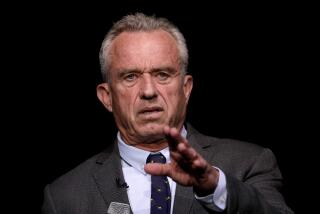A vaccine’s gift
- Share via
In the midst of the Great Depression, President Franklin D. Roosevelt, a survivor of polio, sparked one of the greatest biomedical breakthroughs of the century. He did it by starting a fundraising campaign.
His efforts drew ridicule from those who said the nation could never defeat polio when citizens could barely feed their families. But everyone, Roosevelt argued, could spare a dime. Seventeen years later, the March of Dimes, the campaign Roosevelt began, claimed success in its effort to find a vaccine that, in time, would make the terrifying polio summers a part of American history.
It was April 12, 1955, a decade after FDR’s death, when the nation erupted in celebration. Dr. Jonas Salk’s polio vaccine had been declared safe and effective.
The Salk vaccine, now being celebrated on its 50th anniversary, marked the beginning of the end for poliomyelitis in the United States. The incidence of the contagious disease, which typically strikes young children and can cause paralysis, fell by 85% in two years. The last case of the disease in the United States was recorded in 1979.
Now, in a nation where many children aren’t even aware that polio existed, the anniversary of the vaccine is bringing about a renewed effort to tell the historic tale of success.
Celebrations were underway last week at places including the University of Pittsburgh, where Salk’s lab was; the University of Michigan, where the vaccine’s success was announced; and the Salk Institute, a La Jolla research facility founded by Salk.
Recently released books, including “Polio: An American Story,” by David M. Oshinsky, describe how polio changed the social and medical landscape of the country. Others, such as “Living With Polio: The Epidemic and Its Survivors,” by Daniel J. Wilson, focus on more personal stories.
The polio vaccine is also the focal point of an exhibit that opened Tuesday at the Smithsonian Institution’s National Museum of American History in Washington, D.C. The 3,000-square-foot exhibit is designed to educate adults and children alike about the triumph over polio.
“It was a great national victory, and a wonderful example of the will and determination of everyday people to fight back and overcome terrible adversity,” said Dr. Jennifer L. Howse, president of the March of Dimes, which is sponsoring the Smithsonian exhibit with the Salk Institute and Rotary International.
Smithsonian curators Katherine Ott and G. Terry Sharrer are using interactive displays to interest younger visitors. A science station allows visitors to create a model of the polio RNA sequence and visitors can experience a tank respirator -- otherwise known as an “iron lung” -- in which many polio victims were confined.
Some of the artifacts on display include FDR’s leg braces and a wheelchair used by Ed Roberts, a California polio survivor who advocated for the rights of the disabled.
“With hindsight, we see all the places where polio had an impact,” Ott said. Many aspects of the universal design movement, such as level subway platforms and lowered water fountains, accommodated the physical limitations of polio survivors.
Rita Bourgois, who contracted the disease in 1954, applauded the effort to bring its story back to life. She and her brother, who also had polio, were told by doctors that they were the only polio patients to walk out of their treatment hospital that year.
“As a child, we didn’t know what was going on,” she said. “We knew we had polio, but we didn’t know how serious it was, or all the fear it created.”
The effort to eradicate polio globally is still underway. Polio was present in more than 125 countries in 1988; by 2004, only 11 countries reported the disease.
“We knew in 1985 that the virus didn’t represent a great threat against America,” said William Sergeant, who heads Rotary International’s polio effort. “We were determined to do something for the children of the world.”
The polio virus requires a living host, and poses the biggest challenge in densely populated countries with many children, such as India, Sergeant said. An oral vaccine developed by Dr. Albert Sabin and introduced in the 1960s has made large-scale vaccinations possible. On just one day in January 2003, more than 165 million Indian children were immunized.
Immunizing Muslim communities has proven difficult, said Anil Garg, a Rotarian who has traveled to India four times to work with the polio program. In Nigeria and India, some Muslims remain distrustful, fearing that the Western-led immunization effort aims to sterilize Muslim children. Even after strong cooperation from Muslim leaders, 60% to 70% of polio cases in India are in the Muslim community, Garg said. In one heavily Muslim area of Nigeria, vaccinations resumed in July 2004, after a 10-month suspension that caused the virus to be reintroduced into several polio-free nations.
Rotary has pledged that it will stick with the campaign until the disease is documented as being eradicated, which requires three years free of outbreaks.
“Anything worthwhile goes through these sort of things,” Sergeant said of the setback in Africa. “Things that are really important never are easy.”






